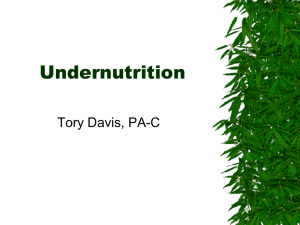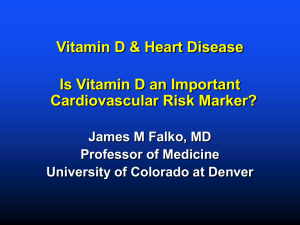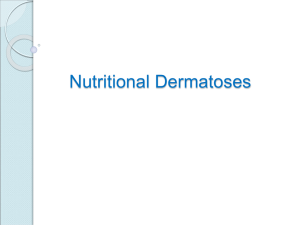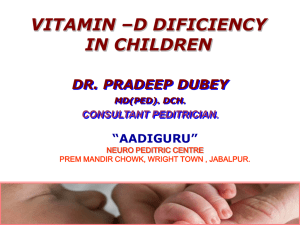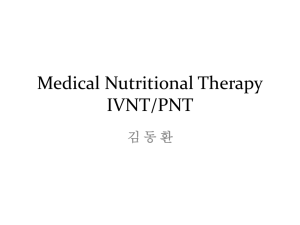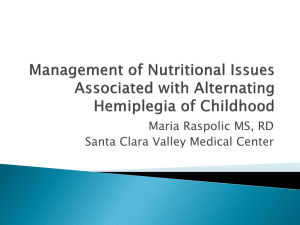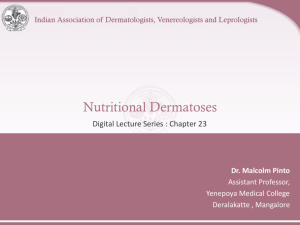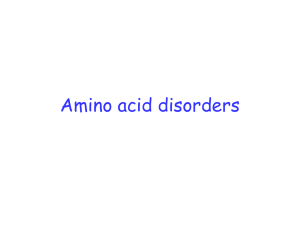Specific Nutrient Deficiencies
advertisement
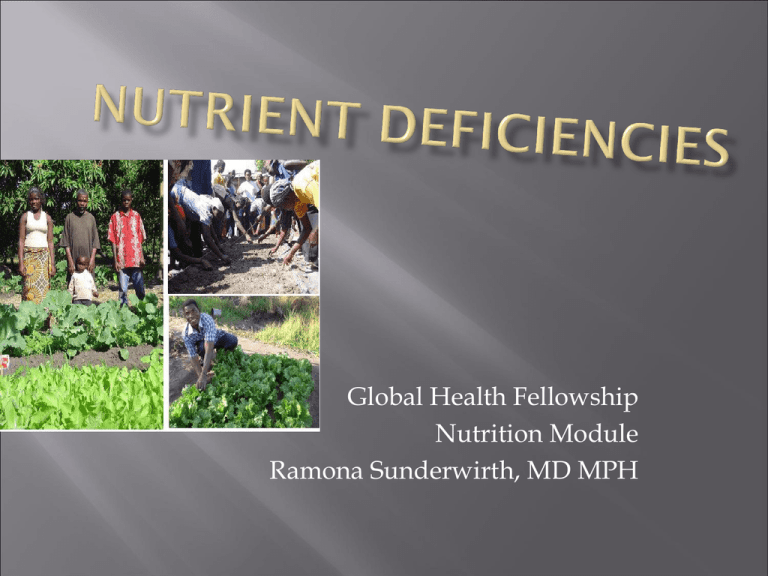
Global Health Fellowship Nutrition Module Ramona Sunderwirth, MD MPH Calcium & Vit D Iodine Zinc Vit A Thiamine (Vit 1) Niacin Vit C Evidence shows that energy deficits more general than protein deficit in community & hospitals 1ary protein deficiency: Staple food cassava or plantain Mothers feed inappropriate foods (sugar water) A major precipitating factor in Kwashiorkor Sufficient carbs in diet spares protein from being used as substrate for glucose Varied diet, proteins from plants & animal sources increases NPU Variety & balance Long chain PUFAs alfa-linolenic & linoleic acids only available in diets Requirements EFA small gross deficiencies in bowel resection s/p weaning in many communities: cognitive impairment , (-) impact on community development Good intake of LC-PUFAs beneficial to health Breast milk critical source on LC-PUFAs Major influence on brain development Absorption Dietary Non dairy diets in Africa: low Ca Rural African mothers: low Ca in breast milk Deficiency Aided by Vit D, regulated Parathyroid hormone Stunting in children Ca deficient Rickets rare Sources Milk, dairy products, fish (bones), beans, peas, dark green leaves, nuts, millet Function Sources Fat soluble vit, stimulates intestinal Ca absorption Fortified food products richest source Vit D Fish oils, egg yolks, mushrooms Animal products (fatty parts, liver) Vit D in diet: cholecalciferol or ergocalficerol Converted to active form 1,25-dihydroxyvit D3 in skin, liver & kidney Requires ultraviolet light Deficiency Interaction of low dietary sources + lack exposure sunlight Rickets ↓Sun exposure, ↓ Ca nutritional requirements ↓serum Ca → induce ↑ PTH secretion → osteoclasts ↑ resorb bone → demineralization of bone & cartilage at sites of rapid growth & remodeling #Limited exposure to sun *limited sun exposure: poor air quality live > 37TH parallel cultural, social habits, dress codes darkly pigmented skin #Nutritional deficiencies *breast milk low in Vit D, weaning diets (low in fats/oils) * inadequate intake Ca (↑consumption polished rice), Phosphate * diets w/ ↑ content phytate (wheat - binds Ca in gut) * ↓ energy supplies, growth outstrips Ca availability #Genetic causes *Vit D-dependent rickets type 1&2 #Malabsorption (repeated GI infections) #Chronic renal, liver disease Early Craniotabes, head asymmetry, frontal bossing, delayed closing ant fontanelle Delayed tooth eruption, abnormal formation enamel, cavities Rachitic rosary Late Pigeon chest irregularity, Harrison groove Motor delays, hypotonia (muscle weakness) Classic limb abnormalities Genu varum, genu valgum, windswept deformities Fraying, widening, cupping metaphysis long bones, fxs Lordosis, kyphosis, scoliosis Narrow pelvis: obstructed labor Muscles Delayed motor development Tetany, carpopedal & laryngeal spasm Convulsions Pneumonia 2ary defective immune function Thorax deformity (restrictive airway) Cor pulmonale Biochemistry Radiology Serum Ca: Nl or ↓ Serum Ph: ↓ Alkaline Phosphatase: ↑ Hydryxyproline excretion: ↑ Radius/ulna: widened, cupped, frayed ends Costochondral junctions: widened Osteopenia Bone biopsy Inadequate mineralization Excessive volume of osteoid tissue Sunlight or ultraviolet light Calciferol Tetany IV Ca Gluconate 10%solution ( 5-10ml) PO Ca Chloride 1g q 6 h ( in milk) Ca supplements PO or IM Vit D2: 150K i.u. once PO calciferol: 3K i.u. (75mg) QD x 1 mo Cod liver oil (75 i.u./ml or 1.8mg/ml) QD x 1mo Milk or Ca lactate tab 5g TID Healing 6 wks Vit D treatment biochemical changes reverses Bones heal more slowly, may never become normal Community Health Education Need for sunlight & animal foods (eggs) Fish oil for children at risk: premies/infants/patients Iodine > thyroid hormones Regulation of growth, development & metabolism Commonest thyroid disease is goiter, response to insufficient I intake All body systems vulnerable to I deficiency CNS (fetal life & infancy-3yr age) Milder degrees of MR affect whole populations Hypothyroidism → Goiter Subclinical I deficiency Loss energy Brain damage Iodine deficiency in pregnancy → cretinism infants (MR + stunted growth) Endemic Goitre Soil deficient Marginal I deficient areas, precipitated by consumptions of goitrogenic agents in food: poorly cooked roots (cassava)/leaves Fetus Neonate Abortions, stillbirths, congenital malformations ↑PNM, neurological & myxoedematous cretinism NN hypothyroidism Child & adolescent Retarded mental & physical development Adult Goitre I-induced hyperthy (IIH) All ages Goitre, Hypothy Impaired mental function ↑ susceptibility nuclear radiation I content water & food reflects levels in soil & groundwater I sources: animal>fruits/vegetables Goitergens Thiocyanate ( from cassava) Selenium deficiency, high levels fluoride Soil erosion Inland, mountainous areas w/ poor soils & hi rainfall + coastal areas, large cities Public Health Problem Reduces potential of whole community Low achievement, poor quality life, blunted ambition Urinary iodine Thyroid size (goitre surveys) Most useful/reliable indicator I status 24hr or random (30 samples) urine collection Related to recent dietary I intake 100mico gm/l satisfactory Palpation, ultrsound (more reliable) “Total Goitre Rate”, schoolchildren TSH NN screening programs For early detection of congenital NN hypothyroidism Useful epi information severity of I deficiency, not cost effective to monitor IDD programs Mild Goitre Moderate Severe 5-19% 20-29% >30% Median Urinary I 50-99 20-49 <20 TSH > 5mU/L 3-19% 20-39% >40% Consumption of adequate amounts I (150microgm/d) Sea fish, kelp Supplementation programs Iodization of water or salt Direct administration I oil: IM or PO Iodine solutions (Lugol’s iodine): regular PO dose Iodization of all salt for human consumption Sustainable , costs borne by consumer K iodate recommended (more stable) 20-40mg I/kg salt Monitoring essential Function Cell replication & growth Stabilizing fct in organic compounds (cell membranes) Bone & muscle (total body content: 2-3gm) No known correlation btw intakes & plasma levels Sources Animal products, seafood, cereals (outer layers) Absorption impaired by phytates, protein acts as anti-phytate, aids absorption Deficiency Growth retardation (IUGR) cell mediated immunity wound healing Replacement Strong evidence supports low dose supplementation Reducing diarrhea Reducing mortality Children in several areas of developing world Careful in administration in early recovery phases severe malnutrition w/ chronic diarrhea Retinols Retinol: preformed Vit A Most active form Found in animal sources Beta-carotenes Provitamin A (converted to Vit A in intestines) Plant source of retinol from which mammals make 2/3 of their Vit A Carotenoids Largest group Functions Cell differentiation (eye, mouth, gut, respiratory tract, immune cells, reproduction & growth) Vision (retinal rod & cone cells) & maintenance of integrity of conjunctiva & cornea Sources Retinol: animal products, liver Carotenoids: yellow, red fruits/vegetables & leaves Deficiency Syndromes 3rd most common nutritional deficiency in world S. & SE Asia, Africa & S. America Night, complete blindness & Xerophthalmia in malnourished adults & children 500K preschool school children/yr blind Chronic illnesses can deplete tissue Vit A Disorders w/ fat malabsorption CF, celiac disease, cholestatic liver disease, Crohn’s, pancreatic insufficiency Xerophthalmia Inadequate fct of lacrimal glands Night blindness Bitot’s spots →corneal xerosis →keratomalacia Poor bone growth Dermatological problems Hyperkeratosis, follicular hyperkeratosis, destruction of hair follicles and replacement w/ mucus secreting glands Impairment of humoral & cellular immune system Effects on phagocytes & T cells Community wide administration of Vit A WHO recommended: beneficial effects on immunity ↓ U5MR by 25% Replacement : q4-6 mos Infants 50K IU PO Infants 6-12mo: 100K IU PO Mothers: 200K IU PO w/in 8 wks delivery Pregnant or women of reproductive age: small doses 10K IU/d or 25K IU wkly Hi dose supplementation Children at hi risk Vit A deficiency: *measles, diarrhea, respiratory diseases, severe malnutrition (single dose if no supplement in 1-4 mo) Reduces complications & mortality Treatment Xerophthalmia 3 doses at age specific doses 1st immediately on diagnosis, 2nd the next day, 3rd dose 2 weeks later Functions Co factor for many reactions: amino acid & carbohydrate metabolism, requirements of Vit related to carbohydrate intake Catalyst in pyruvate → acetyl CoA Role in initiation nerve impulse propagation Transketolation of pentose phosphate pathway (WE, WKS) Found in skeletal muscle, liver, heart, kidney, brain ½ life 10-20d, cont. supplementation required Sources Yeast, legumes, pork, rice, cereals Hi cooking temperatures, canning, pasteurization can destroy thiamine (denatured at hi pH/temperature) Beriberi Infantile Adult Wet or Dry Wernicke-Korsakoff syndrome Apparent between ages 2-3 mos Fulminant cardiac syndrome Cardiomegaly, tachycardia, cyanosis, dyspnea Loud piercing cry, vomiting Aseptic meningitis Vomiting, nystagmus, purposeless movements Seizures, normal CSF Dry Symmetrical peripheral neuropathy Sensory & motor distal extremities Acidotic, often w/ chronic diarrhea Wet Neuropathy Cardiac: cardiomegaly, cardiomyopathy, CHF (hi output), peripheral edema & tachycardia Complication of Bariatric surgery & TPN Polyneuropathy w/ burning sensation extremities, weakness, falls Wernicke’s encephalopathy (WE) Acute syndrome, emergent treatment required Nystagmus, ophthalmoplegia, ataxia, confusion Chronic alcoholics w/ thiamine deficiency Wernicke’s Korsakoff syndrome (WKS) Chronic neurological condition, consequence of WE Impaired short term memory & confabulation Otherwise grossly normal cognition Blood thiamine concentration ITKA erythrocyte thiamine tranketolase Transketolase urinary thiamine excretion Requirements: RDA 1.2-1.4mg/d Treatment Beriberi Bed rest IV or IM 50-100mg/d x 7-14 d PO of 10mg/d till full recovery Epi: Endemic in maize eating populations Central & S. Africa Subsist on maize (deficient in tryptophan) & lots alcohol Prisoners, refugees, poor urban/rural Functions Niacinamide & nicotinamide: incorporated into NAD & NADP Function in many reactions : glycolysis, fatty acid/ carbohydrate/protein synthesis & metabolism, respiration & detoxification Sources Plant & animal foods: yeast, meats, cereals, legumes, seeds, dairy products Any hi protein diet of 100g/d (tryptophan → niacin) Deficiency Common in poorer countries w/ local diet cereal, corn, sorghum Alcoholics, complication bariatric surgery/anorexia 3 D’s Dermatitis Photosensitive, hyperpigmentation/roughening skin Forearms, & around neck (“Casal’s Collar) Diarrhea Smooth red & painful tongue, esophagitis, vomiting Dementia Insomnia, anxiety, confusion, disorientation, delusions, hallucinations (like DT) Dementia, encephalopathy, Acute, precipitated by acute infection (typhoid) Carcinoid syndrome INH prolonged use Tryptophan → 5-OH tryptophan & serotonin (rather than nicotinic acid) Isoniazid depletes stores of pyridoxal phosphate, which ↑production tryptophan, precursor niacin Hartnup Disease Autosomal recessive congenital disorder Defect of membrane transport in intestinal & renal cells responsible for absorption tryptophan Nicotinamide Chlorpromazine (for confusion) 50mg TID PO 25-50 mg Requirements 14-18 NE (niacin equivalents) /day Epi Functions Laborers in S. Africa, S. Sudanese migrants Prisoners, constant threat to refugees Patients w/ severe malabsorption, alcoholics, drug addicts Scurvy develops > 6mo severe deficient diet Cofactor, enzyme complement, co substrate, antioxidant in many reactions & metabolic processes (copper, iron, folic acid, Vit E) Collagen synthesis Fatty acid transport (mitochondial membrane w/ carnitine) Neurotransmitters (synthesis of norepi & dopamine) Prostaglandin metabolism, attenuating inflammatory response Sources: Vegetable & fruit Marginal deficiency Signs Bleeding gums, retarded wound healing Peri follicular hemorrhage (early) Bruises, petechiae, coiled hairs, hyperkeratosis Subperiosteal hemorrhages (very painful) Arthralgias, Sjogren’s syndrome Generalized systemic symptoms Weakness, malaise, joint swelling, edema, Depression, neuropathy Vasomotor instability Leukocyte ascorbic test Plasma concentration <0.2mg/dL Xrays in infants Best test to prove deficiency Knees: atrophic b ones, white line (calcified cartilage at metaphysis & epiphysis) Treatment Children: 100mg ascorbic acid TID x 1 week, the QD x several weeks till full recovery Adults: 300-1000mg QD x 1mo Improvement constitutional symptoms 24 hr, skin in wks Principles of Medicine in Africa, Ed E. Parry, R. Godfrey. 3rd Ed. Cambridge 2004 Clinical Manifestations of malnutrition in children, Overview of water soluble vitamins Up to Date
